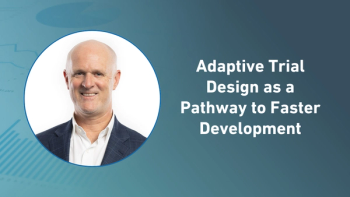
- Applied Clinical Trials-11-01-2003
A Clinical Development Solution Tailored for Biopharmaceutical Companies
The rapid evolution of the biopharmaceutical industry has lead more and more companies to focus on the clinical development of their drug candidates, thus presenting the challenge of selecting the optimal strategy for conducting their clinical programs. Typically, biopharmaceutical companies have had three options: out-licensing their product, setting up their own clinical development operations, or outsourcing the clinical development to contract research organizations (CROs).
The rapid evolution of the biopharmaceutical industry has lead more and more companies to focus on the clinical development of their drug candidates, thus presenting the challenge of selecting the optimal strategy for conducting their clinical programs. Typically, biopharmaceutical companies have had three options: out-licensing their product, setting up their own clinical development operations, or outsourcing the clinical development to contract research organizations (CROs).
Figure 1. Schematic representations of (a) traditional sponsor-CRO interaction and (b) of a clinical development partnership.
A new strategy
A new alternative strategy, which combines the best of the latter two options, has been used successfully over the past three years and may represent a more attractive option to many biopharmaceutical companies. This solution requires a very close, transparent, and flexible partnership with a provider of full clinical development services, with adequate measures and systems to maintain sponsor control and awareness, high project focus by both parties, and very rapid response times owing to constant and open communication. This type of partnership also offers significant opportunities for a transfer of know-how between the partners. This can accelerate and improve the development process for emerging and growing biopharmaceutical companies.
Biopharmaceutical companies are incredibly successful at identifying drug candidates. Technological improvements, such as high-throughput screening techniques and the rise of proteomics and genomics, have made this possible. At the same time, biopharmaceutical companies have realized the need to move from technology platforms to product development to become the future players of the new biopharmaceutical arena. Now, the challenge is to choose the best strategy to take their highest risk ever-bringing drug candidates through clinical development.
Out-licensing
Out-licensing the product or partnering with a large pharmaceutical company with a transfer of the clinical development responsibility can be valid solutions, depending on a company's business model, product portfolio, marketing ambitions, and cash reserves. By not taking the drug through clinical development, however, both options represent a lost opportunity for creating product value. They should therefore be reserved for specific situations.
Internal clinical development
A few companies choose to manage the clinical development of their product by hiring their own staff, often complementing them with contracted individual resources. The main motivations usually are to keep close control of the clinical development process and an expectation of lower development costs. While this certainly allows control and management of the clinical trials, these companies face high initial and running fixed costs, which will rapidly escalate as development progresses. Clinical development requires a variety of expertise and processes to conduct a large number of highly specialized, different activities. No company can assemble such expertise and develop an entire set of processes that adhere to the ever-increasing standards of international and national research in just a few months. Therefore, many of these companies actually lose time (the cost of which is usually not accounted for) and struggle to conduct their programs at required quality levels. Secondly, these considerations are complicated by the international nature of clinical development, which, to achieve efficiency, should be conducted in specific countries based on such factors as product indication, clinical development phase, regulatory frame, and local medical practices. By significantly increasing their fixed cost basis, these companies limit their ability to react in the event of product failure. Thus, the clinical development costs of managing clinical development internally may actually end up being much higher than when choosing an outsourcing strategy, and significant amounts of time may be lost.
Clinical outsourcing
Most biopharmaceutical companies choose to outsource their clinical development program to one or several of the many available CROs. Properly selected clinical CROs can indeed assemble experienced clinical research staff in diverse locations and provide high-quality processes to conduct all clinical research functions in compliance with regulatory requirements. Three critical factors for CRO selection are capability (available resources, experience in the therapeutic area, geographical location, and nature of services), compatibility (of corporate cultures), and cost.
1
However, the performance of CROs has come into question due to lack of clarity on pricing and control.2 Additional concerns have been expressed by emerging biopharmaceutical companies about the level of attention and commitment received by their proportionally small projects in the midst of large CRO preferred-provider contracts with large pharmaceutical companies. As a result, many of those companies regularly switch providers of clinical services and end up with significant time lost and high costs to restart new collaborations for each study, study databases in noncompatible systems or formats and in various locations, and a generally negative impression of CROs.
Measuring CRO performance has been the subject of several reviews, and various metrics have been proposed.3 While metrics are indeed essential in CRO performance assessment, various intangible elements of the sponsor-CRO interaction remain critical to final sponsor satisfaction with the CRO. Some of these intangibles are flexibility, commitment, transparency, and response time. Improvements in these areas have become essential for the CRO industry and are emerging with the new generation of CROs, which support these key operating values with new technological solutions to provide instant access to high-quality data and study progress information.4
The insufficient level of information exchange between CROs and sponsors (mostly perceived or interpreted as lack of transparency) is a key element in clinical project delays. A very good knowledge of the process and of the progress of the clinical project by the sponsor ensures fast reactions and decisions, facilitates sponsor-CRO interactions, and ensures a project-driven approach that may result in saving months on the product's time to market. It is common knowledge that one month of delay in the time it takes for a product to reach the market results in missed product sales of $25 million for a product that would achieve peak sales of $300 million per year. The need for transparency is also absolutely essential to biopharmaceutical companies with limited product portfolios due to the companies' high dependency on the product.
Historically, we have seen over and over again that the issues that arise on internally-run projects also arise on outsourced projects. These situations very rapidly develop into scenarios of placing blame and pointing fingers, and people lose focus from the task at hand-moving the project along.
If there is a spirit of close partnership with shared project teams and common goals, however, analysis of project issues is done as a joint team, resulting in prompt actions, swift resolutions, and continued focus on the best interests of the project.
From working together through the learning curve of the sponsor-service provider relationship, a sense of partnership will develop, enhancing the feeling of a shared ultimate goal-successful product development.
The partnership model
This model was developed over several years and initially implemented by Actelion Pharmaceuticals (see sidebar). It has been successfully reproduced after adaptation to the specific needs of each sponsor. For instance, if the sponsor cannot frequently attend project team meetings, the sponsor reserves a desk for the partner's project manager to spend several days or weeks at the sponsor's office on a regular basis. The advantage of having a project manager from the clinical partner is to increase communication. Both parties can fully benefit from a complete under- standing of the processes involved and direct contact with field and biometric department colleagues. It is easy to see the advantages of having a project manager working closely with the sponsor organization. From this viewpoint, it will be easier to filter information back into the service provider organization, which is a known territory.
Other advantages to this model are Web-based status and data reporting systems. Data can be made available to sponsors at any time. Systems interfaced with validated data management systems can be updated daily to manage and track the project and be accessible through secured Internet connections from virtually anywhere.
Thus, as depicted in Figure 1, this model creates a point of intense sponsor-CRO interaction, which radiates within the clinical development organization and its suppliers or partners.
Opportunities
Small biopharmaceutical companies are evolving fast. Most of the time they would prefer to internalize key functions within the company, but the need for activities typically performed by these functions may arise before internal resources and their related ICH/GCP processes have been implemented. A typical example may be the handling of serious adverse events and their reporting to health authorities. There is a constant exchange of process know-how and a flexible adaptation of each partner to the progress of the sponsor's infrastructure when flexibility exists within the partnership. Thus, certain tasks may be taken over by the sponsor along the way, in particular for programs of long duration. This gives time for the sponsor to set up an internal organization, which will then be able to operate with the same or very similar processes estab-lished with the experienced partner.
The same principles may be applied to biometrics services. The use of validated systems meeting regulatory requirements is paramount to any clinical development program aimed at obtaining registration under ICH regulations. The setup of such systems is expensive and requires much time and experience. Therefore, the sponsor may decide to leave the database with the partner, yet progressively develop their own statistical expertise for data analysis and reporting as well as establish independent access to high-quality data.
Emerging biopharmaceutical companies make great efforts to build and maintain their image within the life science investment community. They should also not miss the early opportunity to build their name recognition and image within the clinical research community. The better their image, the more likely study investigators will develop loyalty and support for the company. Investigators prefer working directly with a sponsor rather than dealing with representatives of a large CRO.5 Due to limited staff and geographic presence, this is difficult for small biopharmaceutical companies. Through a clinical development partnership, the sponsor and its partner create a combined entity dedicated to the project, "the partnership," whose interest is to develop the sponsor's name recognition.
Conclusions
Co-management and integration of key resources to ensure flexibility, commitment, project focus, and full control by the sponsor has been tested for over three years and has shown excellent results.
This partnership solution-based on mutual trust, transparency, and synergies of expertise-allows the sponsor to keep full control of the development program despite employing external resources. It has the potential to provide key long-term benefits to the biopharmaceutical company, such as guarantees of meeting regulatory requirements and opportunities to develop its own operations progressively according to proven and established processes.
The achievements in time savings are substantial, although always difficult to calculate accurately. The best evidence is provided by the record time achieved by Actelion Pharmaceuticals with its Tracleer" pulmonary hypertension product, which went from start of Phase II to product launch in the U.S. market in only 30 months. The time saved was estimated at approximately six months, with savings per month estimated between $10 million and $30 million.
Thus, this approach may represent the option of choice for emerging and growing biopharmaceutical companies facing a need for experienced clinical development resources and which do not wish to fully outsource this critical investment due to an expected lack of pricing and control strategy.
References
1. J.R. Vogel and N. Resnick, "Achieving Results with Contract Research Organizations: A Case Study in Evaluating and Selecting a CRO,"
Applied Clinical Trials
, June 1996, 30-36.
2. M. Cuddigan and M. Driver, "Keeping Score in Clinical Outsourcing," Scrip Magazine, October 2002, 51-53.
3. T. Hill, "Can CROs Measure Up to Their Claims?," Scrip Magazine, March 2002.
4. M. Bowden and S. Mckenzie-Lawrie, "Looking to the Next Generation of CROs," Scrip Magazine, March 2002, 36-37.
5. CenterWatch 2001 Survey of 405 Investigative Sites (CenterWatch, vol. 8(7), pp. 4-7, July 2001).
Articles in this issue
almost 22 years ago
Squeezing the European Union Into Shapealmost 22 years ago
When to Hold ?Em, When to Fold ?Emalmost 22 years ago
Recruitment Rates and Data Quality -- Are They Linked?almost 22 years ago
NIH Seeks to Re-Engineer Clinical Research SystemNewsletter
Stay current in clinical research with Applied Clinical Trials, providing expert insights, regulatory updates, and practical strategies for successful clinical trial design and execution.






.png)



.png)



.png)
.png)
